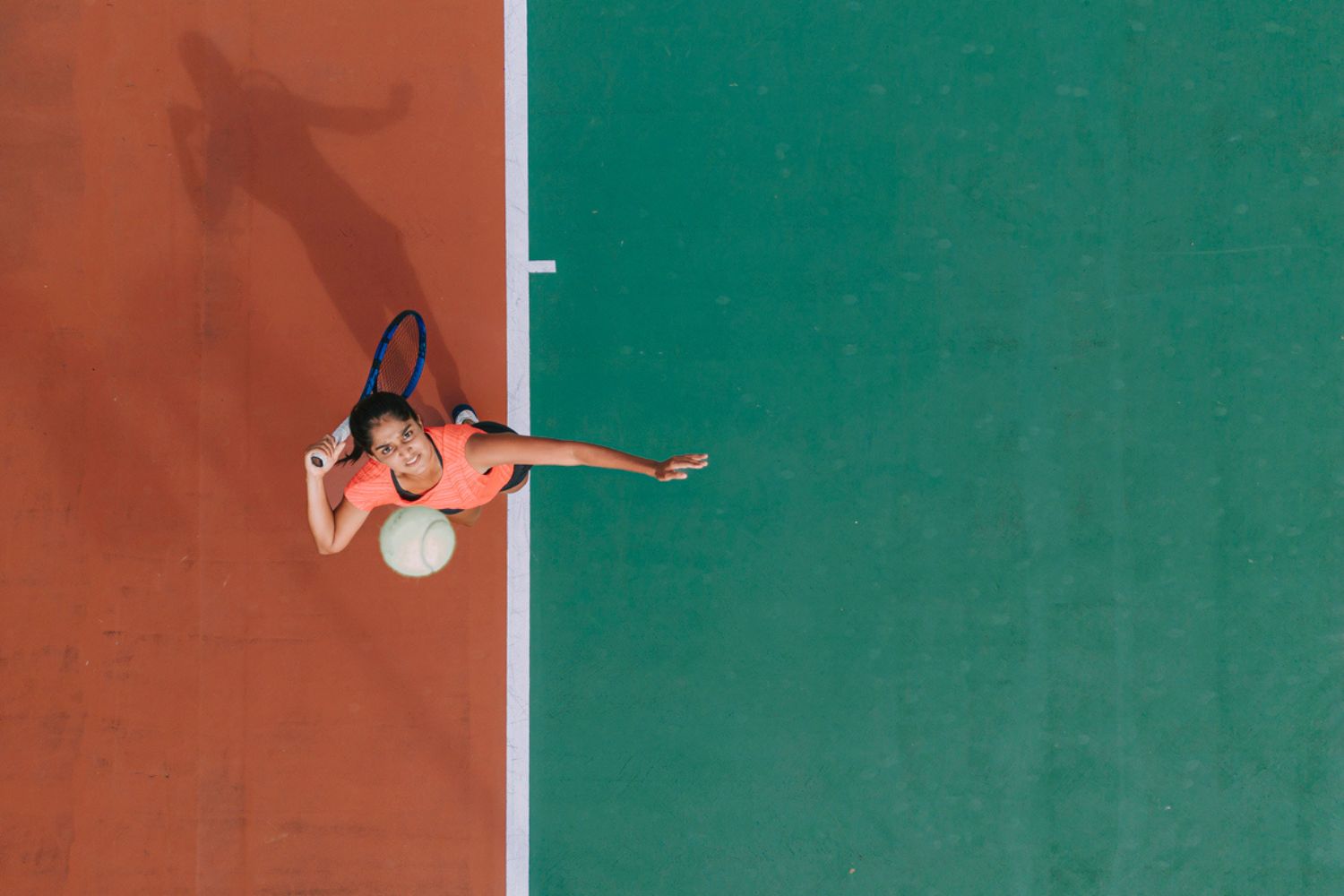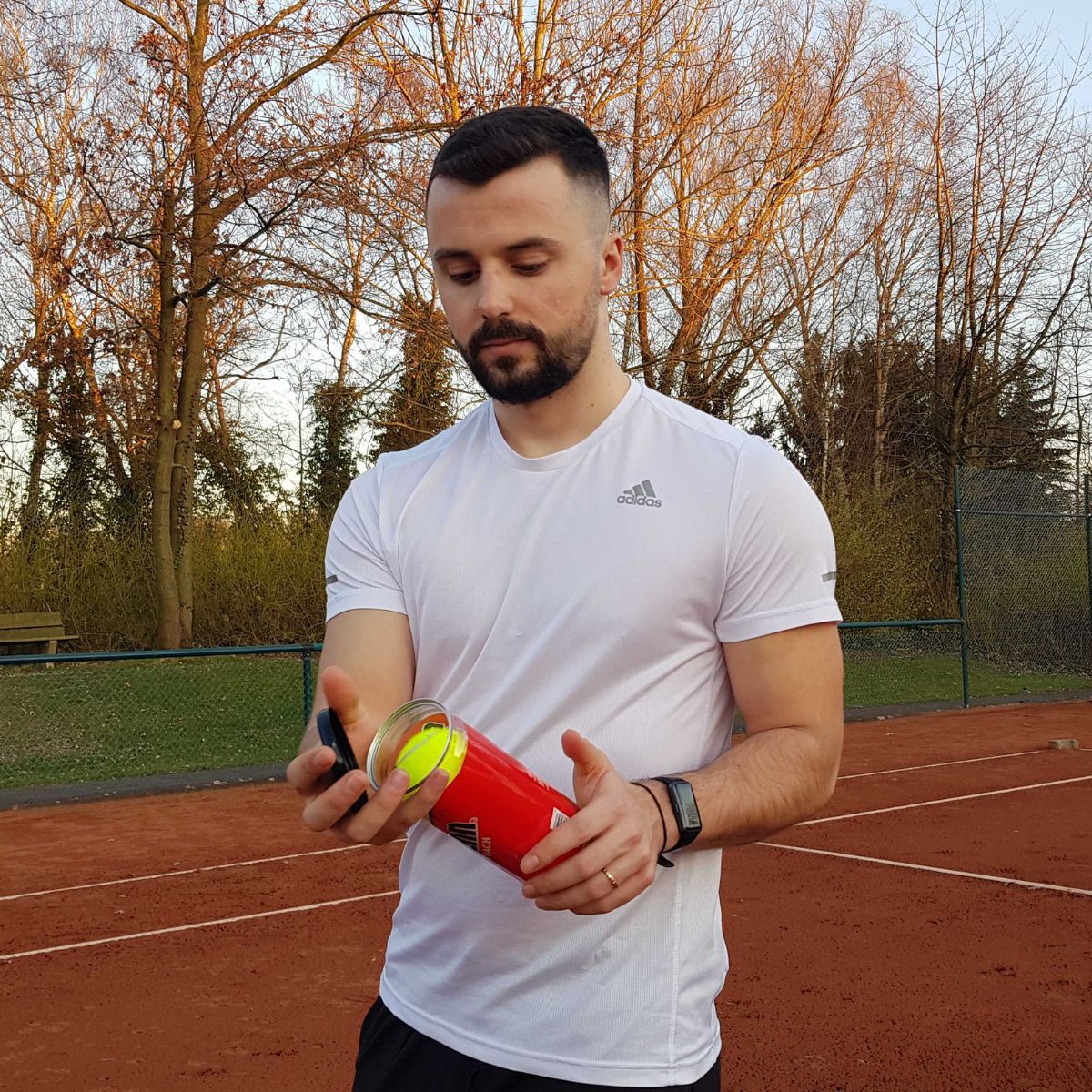Learning how to serve in tennis is one of the most important skills a player needs on the court, regardless of the perfomance level. This is also the most complicated stroke of all due to the complexity of the motions, so stroke can be quite difficult to master. The proper way to learn how to serve is by following step-by-step progressions in order to build a technically correct service from the ground up.
This article follows up a series of tennis serve tips that helps our readers learn everything about the fundamentals of the game. This time we will teach you how to hit a proper tennis serve, even if you have minimal experience in the game. Keep scrolling!
Where do You Serve in Tennis?
In tennis, every point starts with a serve. To determine who starts first, usually, the players flip a coin, which is called a toss. If you call the right side, then you get to serve first, but your opponent can choose the side of the court. Here’s the good news; you get to serve twice, even if you miss the first serve.
So where do you serve in tennis, you might ask? Position yourself behind the baseline, in between the center point and the sideline. When serving, you should remain in a stationary stand, diagonally to the service box across the court.
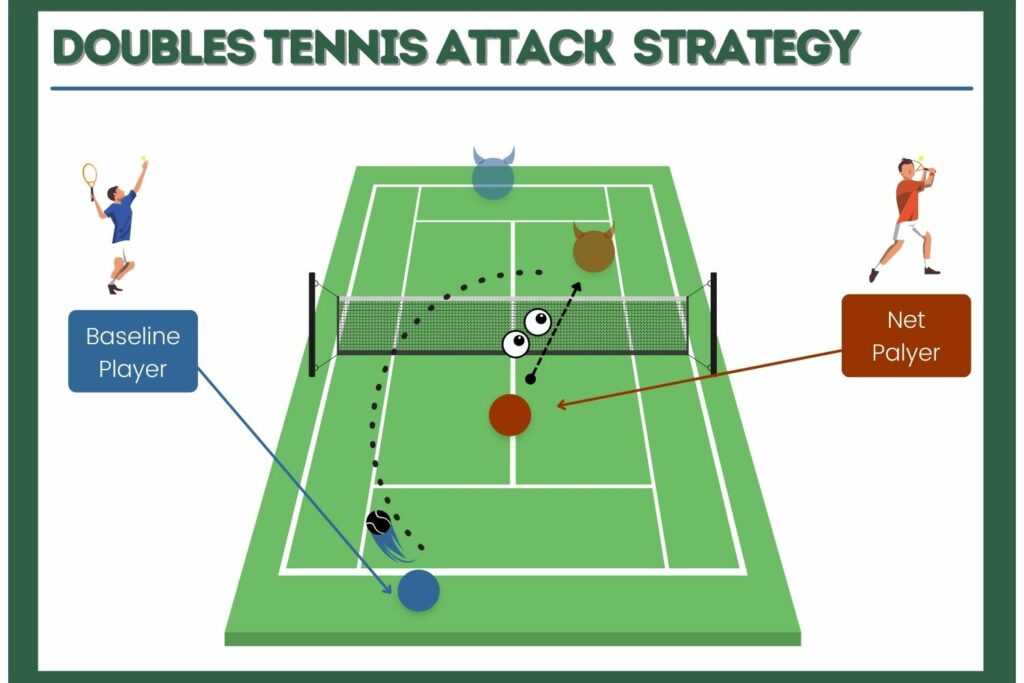
How to Serve in Tennis: Step by Step
To make the tennis service instruction as simple as possible, we made sure to break it down into a few simple steps so that even a fresh beginner can easily understand the right positioning, motions, and techniques that follow a serve.
Step 1: The stance.
First and foremost, you have to take the proper stance which will help you to deliver the perfect tennis serve. Now, this is very important, and you should practice the stance first until you learn it by memory because if you mess up the first step, chances are that the service will fail.
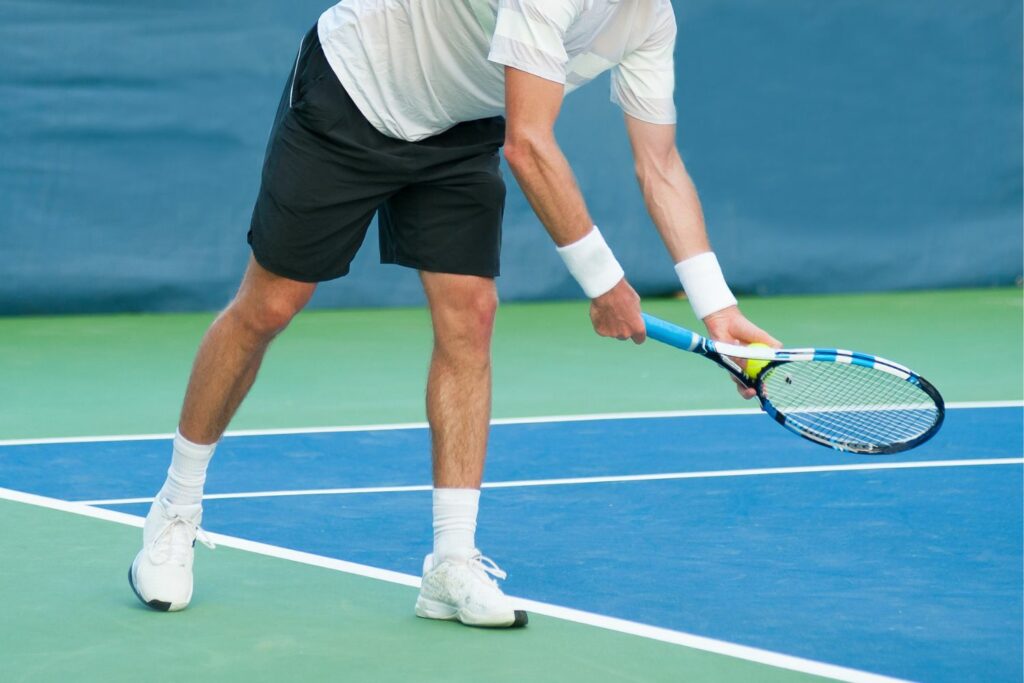
To take a solid service stance, do as follows;
- Go at the service standing position behind the baseline;
- Position yourself in a way that your left foot is pointing to the right net post;
- Position your right foot parallel to the baseline;
- Make sure to put your feet in a way that the heel of the first foot is aligned with the toss of the back foot.
- Make small adjustments, depending on the direction you are hitting the ball, so that you can be comfortable but don’t lose the form.
Step 2: The proper grip.
When learning how to serve a tennis ball, any coach will tell you to use the continental grip. This might be an oversimplification of the process, but what you should do is basically hold the racket the same way you would hold a hammer. For this, the racket should always be at a perpendicular angle to the ground.
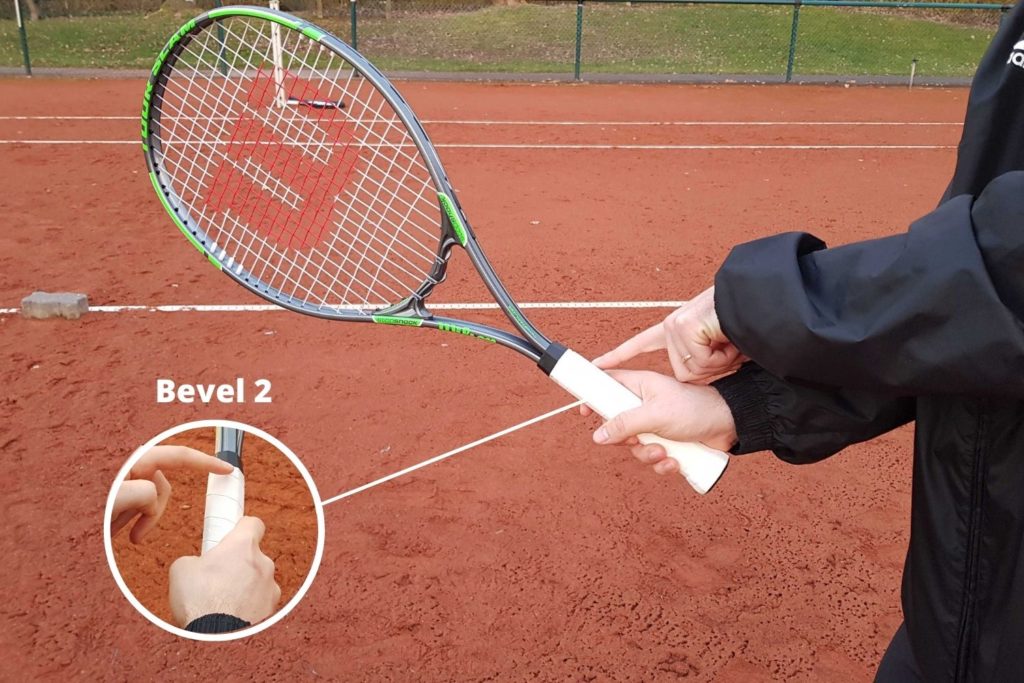
For a continental grip of your racket, you should;
- Position your index finger at the second bowel of the racket
- Wrap the rest of your hand around the handle
Tennis serving for beginners can be quite challenging, so it’s okay if, during the first months on the court, the players go for an eastern forehand grip instead. All you have to do is hold the racket like you are shaking your hand with it. Your index finger should be in the third bowel, while you wrap the rest of your hand around the handle.
This is a very comfortable and easy way to serve, but with time it’s better to switch to continental grip if you want to progress on the game skills.
Step 3: Toss the ball and take the racket back.
The next step is fundamental when learning how to serve in tennis. For learning purposes, we decided to break the motions into small steps, which will make it easier for you to understand.
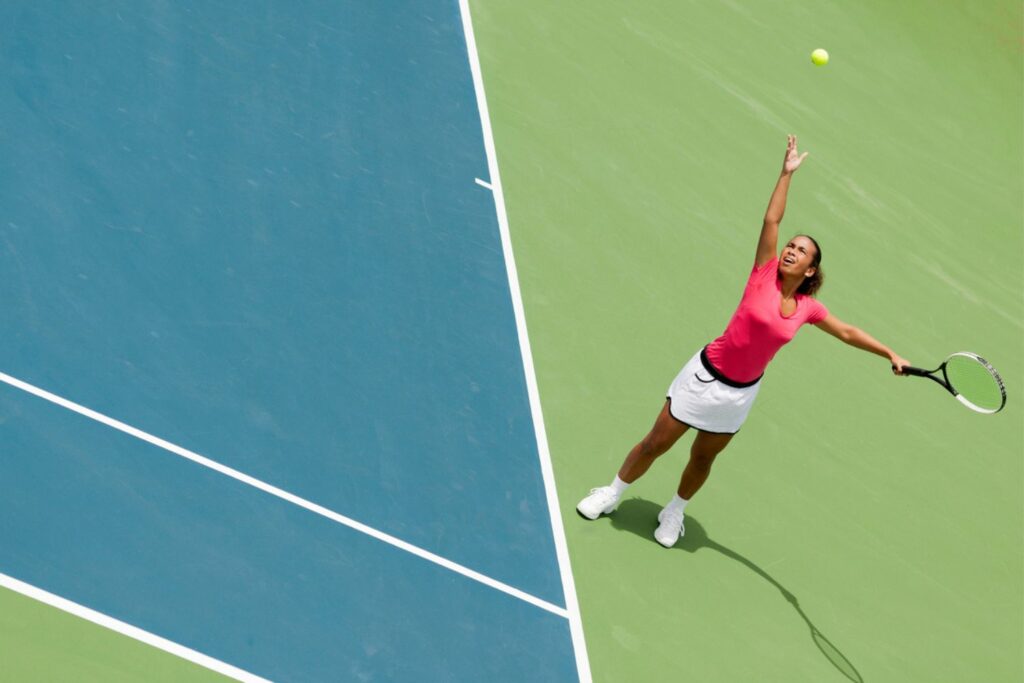
You should now toss the ball up in the air in front of where you are standing. Keep it at a comfortable height, not too high, that makes it hard to reach, but not too low, or else you’ll lose momentum.
- Go in a serving starting position, keeping both of your arms low
- Toss the ball in front of you, shifting the weight of your body forward
- Take the racket on a throwing position (known as a trophy pose)
- Release the ball only when your hand is slightly over your head, and make sure not to add spin or too much force on it.
Step 4: Trophy pose.
The trophy pose or the throwing position is the best way to get into a fluid motion for an effective service. Here’s how you do it;
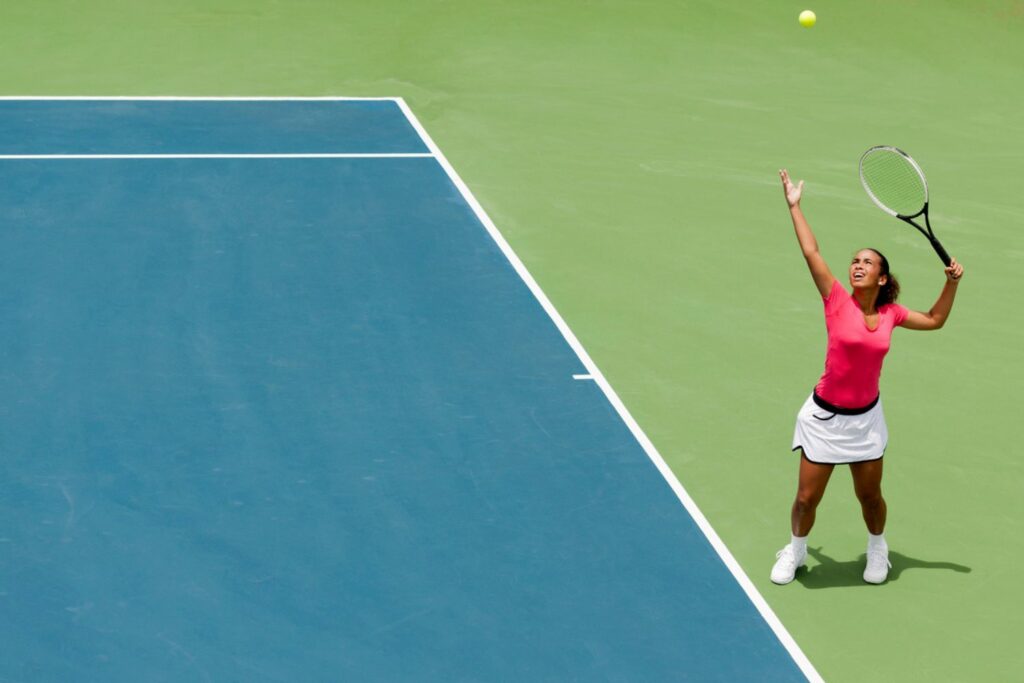
- With one arm, toss the ball, and with the other, hold the racket parallel to your thigh,
- Keep your wrist relaxed, and Make sure to move your racket arm a few seconds slower to give yourself enough time for an effective service.
- Shift your body weight towards the front leg and push the hip slightly forward.
- At this point, the tossing arm should be in the same line position as the released ball while your left shoulder is over the right one.
Important highlight; When doing the trophy pose, advanced players usually can stretch enough to look like they are doing a bow move. They have both the skills and the physical training to achieve this high level of performance.
If you are a beginner or are recovering from a muscle injury, do not attempt to go this far because you can lose balance or even hurt yourself. Keeping yourself grounded and doing the simple steps for the trophy pose, as explained above it’s good enough to hit a successful serve.
Step 5: Swing.
After reaching the trophy position, you should use your body force to push yourself from the ground and jump while swinging at the ball. One of the most common mistakes during service is that the players turn towards the opponent and hit the ball very strongly, using their whole arm and shoulder muscles to finish on their left. This can come as natural for many, but a quick service like this can drain your energy and put you in a disadvantage.
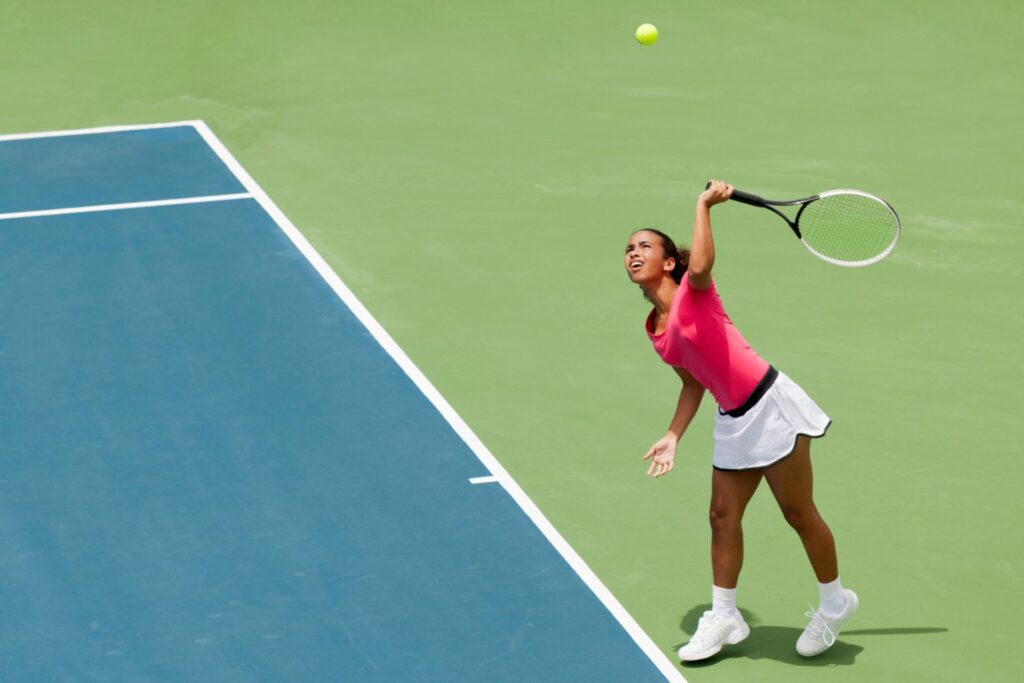
The best way to correct this is by imagining that there are two sings paths instead of one; the first swing path is at a 45-degree angle, while the second one is perpendicular to the net.
- Toss the ball in front of you and swing the ball in the edge at a 45-degree angle
- When the racket is in the same level as the ball, with the strings pointed towards the target, pronate the movement perpendicular to the net.
- Hit the ball
This breakdown of the swinging process during a service will help you to be more efficient at hitting the targets while also creating fluid body motions. Don’t worry about jumping too high or hitting too hard; just focus on executing the movements correctly.
Step 6: Use the sweet spot.
When making contact with the racket, it’s only normal for your whole body to stretch and form a straight line positioning from your left foot to the edge of the racket. This will help you to hit the ball at its highest angle so that you can make a clear shot and generate more speed. To stabilize your body, pull your non-dominant hand down at the same level as your torso.
During this step, make sure to pronate the wrist and aim to hit the ball using the sweet spot of your racket so that the shot can be accurate. Off-center shots are risky because you won’t have much control over the ball, and more often than not, you’ll miss the target or the service box completely.
Step 7: Follow through and land on the court.
The last motion is to follow through with the service, which will naturally make you step into the court. If you are an experienced player, most likely, the upper body will rotate as the dominant hand continues to turn toward the hip after you have make contact with the ball. Keep your losing arm close to the torso, and use your back lack to stabilize the body so you find balance.
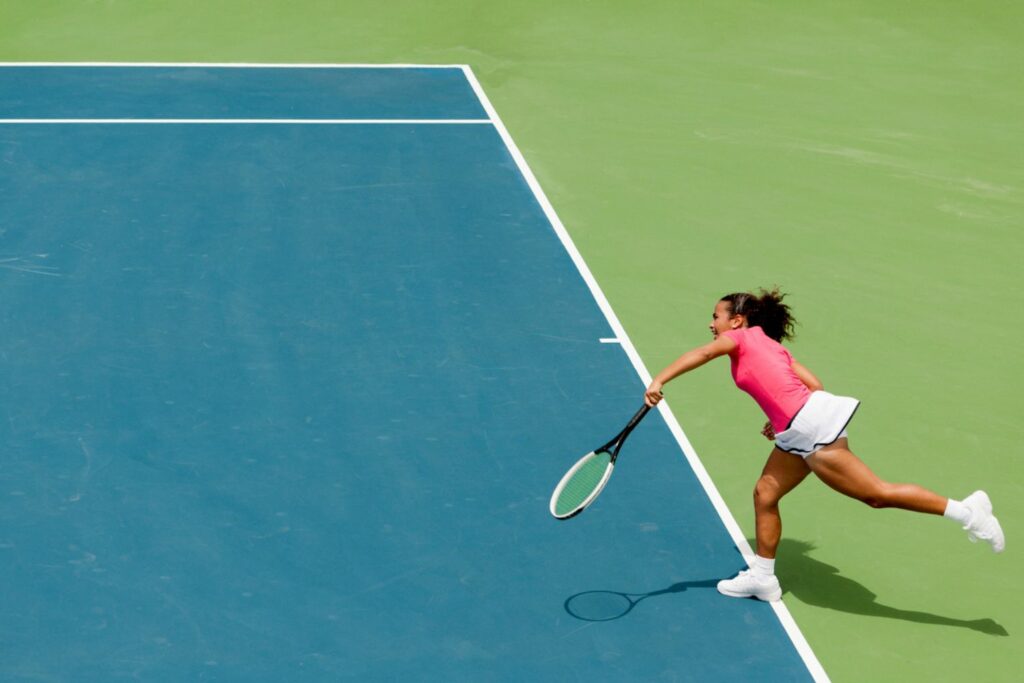
For beginners, it totally okay if the moves are less intense. Instead of jumping, try pivoting your body during the swing motion. Finish the serve by facing your body towards the net and moving up the back heel from the ground to stabilize yourself. When landing on the court, always keep your eyes on the ball and not on your opponent so that you can react faster and build better reflexes.
Step 8: Practise, practice, practice.
We all have heard the famous expression “practice makes you perfect,” and nothing could be more true when applying it to this particular sport. Learning how to serve in tennis and furthermore, mastering this skill can be challenging, even for the most talented player out there.
It’s highly likely that you will continuously fail before getting any good at it. At some point in their journey, even the best players of the world struggled with this. It’s important not to give up and keep practicing.
You can always start by just mimicking the motions at a slow pace so that you can build up some muscle memory. After that, you can start practicing the moves and slowly adding more pace and power to your serve. During your training session, make sure to practice different types of serves and drills, which will help you tremendously in the long run.
Different Types of Serves in Tennis
In total, there are four different types of servings in tennis. Learning to master all of them will elevate your skills and help you develop a game style and strategy that suits you the best.
- Flat serve – it’s fast, is powerful and it usually has no spin. This is probably the most difficult type of serve to master because it requires skills and body force. A perfectly executed flat serve will help you close off the point quickly by coughing the opponent off guard. It makes the returns difficult and weak, and as your opponent is forced to a defensive mode, you can have better control over the outcome of the game. On the downside, flat shots can be inconsistent and make you lose the rhythm, especially if the other player delivers a powerful return. If you are going for a flat serve, make sure to master it properly beforehand and have a good racket that supports flat shoots.
- Slice serve – adding sidespin to the service will make the ball bounce more than usual when hitting the service box. This forces your opponent to move out of position to the deuce side which leaves the rest of the court open. If you can respond fast enough, this will put you at a great advantage and help you close off points with ease.
- Kick serve – it’s an advanced stroke where players add heavy topspin to the serve, which makes up for its signature kick. It allows the player to have a lot of control over the ball while aiming for the opponent’s weakness. With the right skills, the chances for errors are quite low and will help you be consistent and keep pace. Kick serves are perfect for second serves. However, because they are a little slow by default, the opponent has more time reaction time, so keep that in mind.
- Underhand serve – the follow-through motion of this service is very different, forcing the player to make contact with the ball below the shoulder level. As a result, the landing of the ball is slightly over the net, almost like a drop shop, and nowhere near as powerful. Usually, the ball will bounce twice on the service box giving the opponent plenty of reaction time. This service is usually taught to little children or is allowed for injured or elder players; otherwise, the underhand serve is not advised. This type of service is often forbidden for professional competitive players because it is considered “unsporty.”
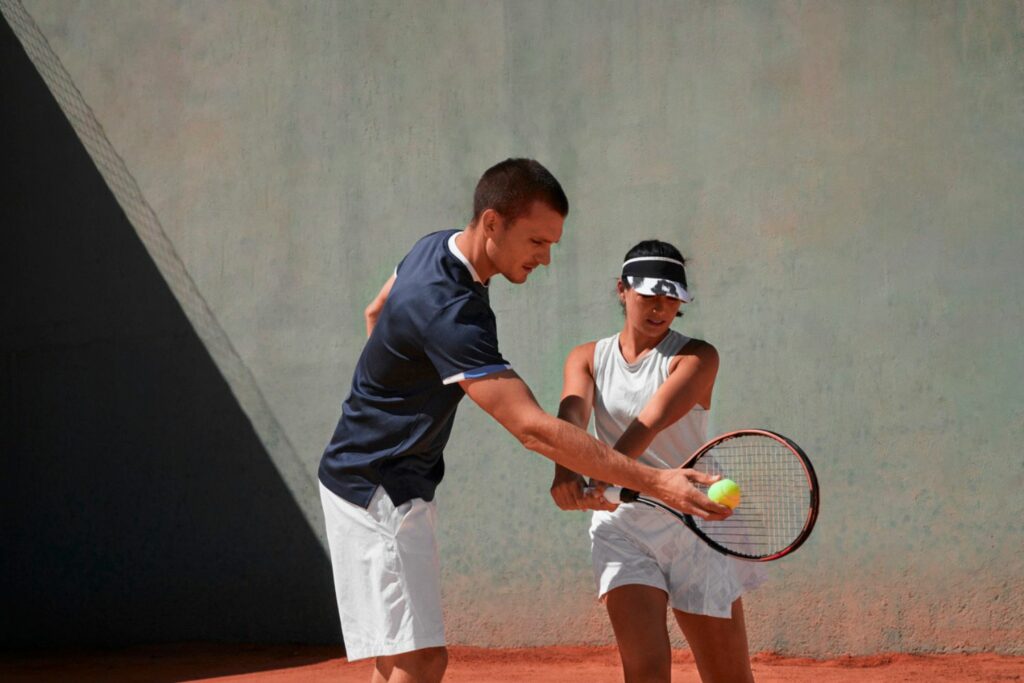
Best Serve Drills
Learning to play tennis is half of the job; the other half is practicing and working on your drills. Now that you know the proper form and mechanical motions, as well as different types of serves, here are some drills that will help you master them.
- Serve with targets drill. It’s simple and effective. Add targets on the other side of the court (little cones, canisters, anything you see fit) on different points of the service line. Pick one, and start hitting at least 10 to 20 serves toward it before moving on to another one.
- Serve consistently drill. Pick a serving box, and start counting every serving you get it correctly. Start from number five and go up one point each time you serve until you reach at least 10 or 15 serves. Each time you miss the service box, you lose one point. It might sound a bit boring, but consistency is key, so keep going.
- The box drill. It’s perfect when you are having trouble with the swinging motion and want to build more power and consistency. For this drill, you should stand on the first line of the court, facing the court with your feet open to the same length as your shoulders’ width. Practice the serving movement as always, but instead of a jump twist the hip, so that you can add more power to the serve.
- Reaction time drill. For this drill, you will need a tennis partner’s help. All you have to do is serve as per usual, but before you make a connection with the ball, your partner should call out the direction of the court for the ball to land. This drill might be challenging at first, but it’s great to build reflection skills and faster response.
- Toss the ball drill. You can start by simply mimicking the toss motions without actually releasing the ball. Then with time, start adding height and power to the ball and continue hitting serves. This will help you find the perfect balance of ball toss and perfect all the moves.
FAQs
If you still have questions about hitting a tennis serve, that’s OK. There’s a lot to know. The following are answers to some of the most frequently asked questions about hitting the perfect tennis serve.
Q. How to do a slice serve in tennis?
The slice serve is one of a tennis player’s most powerful and versatile weapons. Used correctly, it can be an incredibly effective weapon to take your opponent off-guard and gain the upper hand in a match. Here are some tips on how to perform a successful slice serve:
Start with your grip. You will want to use a continental or eastern forehand grip with the handle slightly tilted toward you. This allows for maximum spin on the ball when serving.
Ensure that you have good posture by staying tall and setting your weight over your dominant leg as you reach up for the contact point.
Make sure that at the contact point, you angle the racket downwards so that it makes contact with the outer edge of the ball (this is referred to as “slicing”). The key here is making sure that the back of the hand faces upward at the contact point, thus allowing for an optimal spin on the ball.
Focus on maintaining balance throughout this entire motion from beginning to end – this helps maintain power as well precision throughout the swing path! Finally, remember to follow through with arms by extending them outwards until they are parallel with the net after impact – this ensures proper execution of slice serve, eventually leading to inevitable success!
Q. How do you hit a better serve in tennis?
Hitting a better serve in tennis requires patience, practice, and precision. The key to a successful serve is keeping your tossing arm straight. Your tossing arm should remain perfectly straight as you toss the ball up into the air—this will help you maintain good control over your serve and give it more power. As the ball reaches its peak height, open up your fingers for release so that when it lands on the other court it has as much spin as possible.
Q. How long does it take to learn to serve?
If you’re a beginner with no prior experience, it can take anywhere from 1–3 months if you’re practicing an hour per day by yourself. If you have access to private lessons or group classes, then this timeframe could be shortened significantly since experienced coaches will be able to correct your technique more quickly than teaching yourself through trial-and-error methods.
